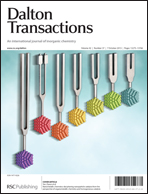DFT calculations using BP86 in conjunction with the SVP and TZVPP basis sets as well as ab initio calculations at SCS-MP2 have been carried out for six dicoordinated carbon molecules CLL′ where L is a fluorenyl carbene while L′ is a phosphine PH3 (1) or PPh3 (2) or a carbene, i.e. NHCMe (3), benzannulated NHCMe (4), cycloheptatrienylidene (5) and benzannulated cycloheptatrienylidene (6). The complexes of these compounds with one and two AuCl moieties were also calculated. The monoaurated adducts of 1–4 have the AuCl fragment η1 coordinated to the central carbon atom. The complexes 5(AuCl) and 6(AuCl) have AuCl η2 bonded across a C![[double bond, length as m-dash]](https://www.rsc.org/images/entities/char_e001.gif) C double bond. Three different bonding modes are found as energy minima for the diaurated species LL′C-(AuCl)2. The AuCl fragments are found to be either both coordinated η1, both coordinated η2 across double bonds, or a combination of the two. According to the electronic structure analysis of the free compounds, 1 and 2 might best be classified as carbenes, 3 and 4 as bent allenes while 5 and 6 are typical allenes. The complexation with AuCl reveals that 1–4 may exhibit chemical behaviour which is typical for carbones and thus, they may be termed “hidden carbones”. The AuCl complexes show that compounds 5 and 6 are classical allenes.
C double bond. Three different bonding modes are found as energy minima for the diaurated species LL′C-(AuCl)2. The AuCl fragments are found to be either both coordinated η1, both coordinated η2 across double bonds, or a combination of the two. According to the electronic structure analysis of the free compounds, 1 and 2 might best be classified as carbenes, 3 and 4 as bent allenes while 5 and 6 are typical allenes. The complexation with AuCl reveals that 1–4 may exhibit chemical behaviour which is typical for carbones and thus, they may be termed “hidden carbones”. The AuCl complexes show that compounds 5 and 6 are classical allenes.

You have access to this article
 Please wait while we load your content...
Something went wrong. Try again?
Please wait while we load your content...
Something went wrong. Try again?
![[double bond, length as m-dash]](https://www.rsc.org/images/entities/char_e001.gif) C double bond. Three different bonding modes are found as energy minima for the diaurated species LL′C-(AuCl)2. The AuCl fragments are found to be either both coordinated η1, both coordinated η2 across double bonds, or a combination of the two. According to the electronic structure analysis of the free compounds, 1 and 2 might best be classified as
C double bond. Three different bonding modes are found as energy minima for the diaurated species LL′C-(AuCl)2. The AuCl fragments are found to be either both coordinated η1, both coordinated η2 across double bonds, or a combination of the two. According to the electronic structure analysis of the free compounds, 1 and 2 might best be classified as 

 Please wait while we load your content...
Please wait while we load your content...